- Related articles
- All Cisco DWDM-XENPAK-50.92's information (List price, Specs, Datasheet PDF, Compatibility
- The Things You Need to Know about 10GBASE-EW Ethernet Standards
- All Cisco DWDM-XFP-54.94's information (List price, Specs, Datasheet PDF, Compatibility ma
- Optical Transceivers for Cisco IE-3000-8TC-E Switch
- The Cisco Compatible GlC-T SFP From Cozlink
- Optical Transceivers for Cisco WS-C2960C-8PC-L Switch
- Optical Transceivers for Cisco WS-C3560CX-8XPD-S Switch
- All Cisco ONS-XC-10G-I2's information (List price, Specs, Datasheet PDF, Compatibility mat
- What is fiber optics used for?
- Optical Transceivers for Cisco SF102-24-UK Switch

Single-mode fiber specifications are divided into two categories, one for ITU-T G.65X series and the other IEC60793-2-50. The communication industry requires a variety of single-mode fiber jumpers, and jumper types are often determined by the diversity of single-mode fiber. In general, there are 19 different single-mode fibers, whose models are defined by ITU-T. The following table is the type of single-mode fiber. In this article, we will focus on the differences among single-mode fiber g.65x series specifications.
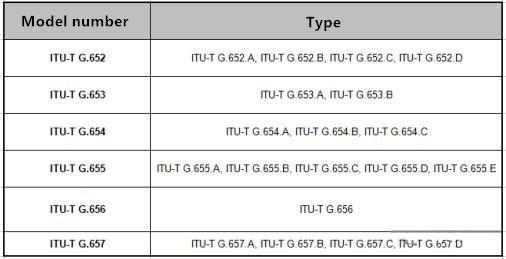
G.652 Single-mode fiber
ITU-T G.652 fiber, also known as standard single-mode fiber (single-mode fiber), is the most commonly used fiber. It has four variants (A, B, C, D). The main zero dispersion points G.652 B fiber are at 1300nm, so they operate at 1310 nm and are optimized. While in the 1550nm band operation is not optimized due to the high dispersion of this region. These fibers are typically used for LAN and access network systems. The other two classes (G.652.C and G.652D) can be used for supporting coarse wavelength division multiplexing (CWDM) transmission between wavelengths of 1310 nm and 1550 nm.
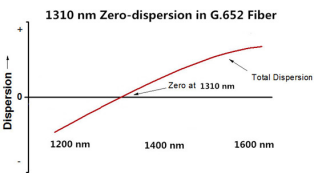
G.653 Single-mode fiber
G.653 fiber is developed in order to make a low-loss and zero dispersion at the same operating wavelength. It uses a core area with more complex structure and a very small core area and makes the lowest loss in the fiber when the wavelength of the zero dispersion is transferred to 1550 nm. So G.653 fiber is also called dispersion-shifted fiber (DSF). G.653 channel spacing is small, which is likely to produce non-linear effects. The four-wave mixing (FWM) is the most troublesome, which occurs in dense wavelength division multiplexing (DWDM) zero dispersion systems where crosstalk and interference between channels are very serious.
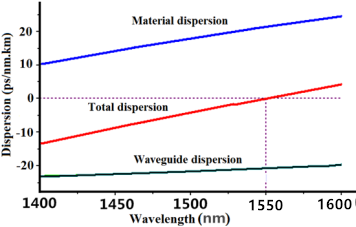
G.654 Single-mode fiber
G.654 fiber is "cut-off single-mode fiber". Its core is made of pure silica, using a larger core size of 1550 nm low attenuation to achieve the same long-distance performance. Its high dispersion is at 1550nm not at 1310nm. All G.654 fibers have a higher power level between 1500 and 1600 nm, which is an extension of the application for long distance submarines.
G.655 Single-mode fiber
G.655 fiber is called a non-zero dispersion shifted fiber (NZDSF). It has a small C-band (1530-1560 nm) dispersion, relatively large core area G.653 fiber, G.655 fiber to overcome the four-wave mixing and other non-linear effects. The following picture describes the dispersion characteristics of the four main single-mode fiber types. The dispersion of a typical G.652 standard fiber is 17 ps/nm/km. G.655 fiber is mainly used to support remote systems using DWDM transmission.
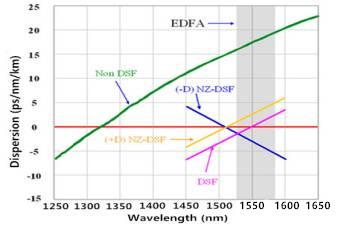
G.656 Single-mode Fiber
As an optical fiber that works well over a range of wavelengths, it is desirable to have some special designs for working at a particular wavelength. G.656 fiber is also known as medium dispersion fiber (MDF). It is dedicated to local access and long distance transmission with a good performance at 1460nm and 1625nm. This type of fiber supports remote systems using CWDM and DWDM to transmit to the specified wavelength range. At the same time, it allows the rapid deployment of CWDM in the metropolitan area network to improve the capacity of fiber in DWDM system.
G.657 Single-mode fiber
G.657 fiber is compatible with G.652 fiber but has different bending sensitivity performance. Its research and development are to solve the problem of optical bending performance, thus, spring fiber jumpers solve the problem of jumper bending when the fiber is wired. G.657 fiber makes the optical signal through a light ditch and makes reflection back to the core, rather than lost in the cladding. It is a fiber with greater bending performance. We all know that it is difficult to control the bending radius in the areas of cable TV and fiber to the home. G.657 is the latest standard for FTTH applications, the most commonly used in the last mile of the fiber network.
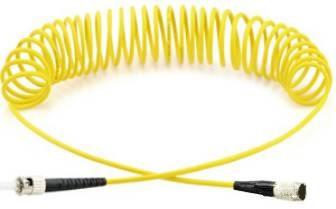
Conclusion
Through the above research, we know that different types of single-mode fiber have different applications. G.657 fiber is compatible with G.652 which planners and installers often use. In fact, G657 has a larger bending radius than G.652, making it ideal for FTTH applications. Due to the loss of G.643 used in WDM systems, it is now rarely used and is being replaced by G.655 while G.654 is mainly used for subsea applications.





































































